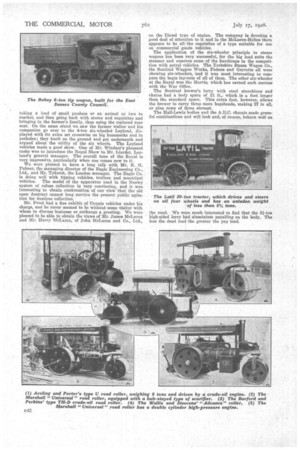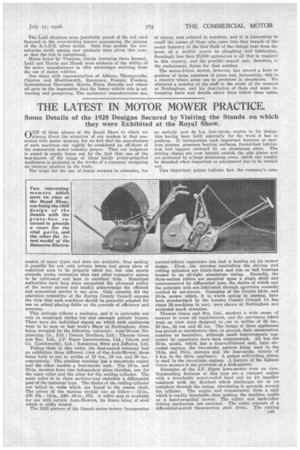A " ONCE-OVER " AT THE ROYAL SHOW,
Page 63

Page 64

Page 65

If you've noticed an error in this article please click here to report it so we can fix it.
The Impressions Obtained from Our Conversations with Leading Trade Men on the Nottingham Show Ground.
THE opening day of the Royal Agricultural Show was this year somewhat less interesting than usual, and a number of men in the commercial-vehicle industry showed considerable prescience in deferring their visit until the Thursday. Nottingham was suffering from an embarrassment of good things last week. The visit of Their Majesties on Tuesday for the opening of the new University College buildings, the princely gift of Sir Jesse Boot to the citizens
of Nottingham, naturally attracted the majority of the inhabitants, and a fair number, we suppose, succumbed to the wiles of the Nottingham races—some speed contests between racehorses, we believe.
At any rate, the attendance on the opening day was, to our way of thinking, much below the normal for a Royal Show; one of the indices being the case with which one could get a seat in the luncheon tents at any moment. Talk
ing of lunch reminds us that the caterers to the Royal Show seem to have no difficulty in getting half a guinea for what is, after all, a very simple cold lunch. They have a 7s. 6d. lunch and a s. lunch, which we believe compare well for value. This year, however, they had two tea tents, one at
2s. and the other at 4s. 6d. The latter figure included strawberries and cream, so we noticed, but as that delicacy does not appeal to us at all we were glad we had come upon the 2s. tent first! The catering at the Royal is always extremely well done, and when one considers the work of construction and equipment, the transport of the plant and materials and their removal, the probable heavy losses by breakage and the risk arising from bad weather and poor attendance, one cannot regard the charges as at all excessive.
As we were saying, the trade chiefs must have foreseen the effect of the visit of the King to Nottingham, and had decided to postpone their own attendance at the Show until Thursday, for the number of principals and leading men whom we met on Tuesday were few, but a quick run round on the Thursday by a member of the staff was productive of a greater number of handshakes and many more cordial greetings.
The farmers seemed to be interested in every type of vehicle, and we found them very searchingly scrutinizing the Trojan with its convertible body, suitable for
taking a load of small produce or an animal or two to market, and then going back with stores and requisites and bringing in the farmer's family, thus using the replaced rear seat. On the same stand we saw the farmer visitor and his companion go over to the 4-ton six-wheeled Leyland, displayed with its axles set crosswise on big hummocks and in potholes; they knelt on the ground and got underneath and argued about the utility of the six wheels. The Leyland vehicles made a good show. One of Mr. Windsor's pleasant tasks was to introduce the Royal Show to Mr. Liardet, Leyland's general manager. The overall tone of the Royal is very impressive, particularly when one comes new to it.
We were pleased to have a long talk with Mr. R. G. Palmer, the managing director of the Eagle Engineering Co., Ltd., and Mr. Tyhurst, the London manager. The Eagle Co. is doing well with tipping vehicles, trailers and municipal vehicles. The model of the apparatus used in the Neuwy system of refuse collection is very convincing, and it was interesting to obtain confirmation of our view-that the old open dustcart cannot long survive the present public -agitation for dustless collection.
Mr. Frost had a fine exhibit of Dennis vehicles under his charge, and he never seemed to be without some visitor with whom to discuss business or exchange a greeting. We were pleased to be able to obtain the views of Mr. Fames McLaren and Mr. Harry 'McLaren, of John McLaren and Co., Ltd.,
on the Diesel type of engine. The company is devoting a good deal of attention to it and in the McLaren-Helios there appears to be all the requisites of a type suitable for use on commercial goods vehicles.
The application of the six-wheeler principle to steam wagons has been very successful, for the big load suits the steamer and removes some of the handicaps in the competition with petrol vehicles. The Yorkshire Steam Wagon Co., the Sentinel Waggon Works, Fodens and Garretts all were showing six-wheelers, and it was most interesting to compare the bogie lay-outs of all of them. The other six-wheeler at the Royal was the Morris, which has earned such success with the War Office.
The Sentinel brewer's lorry with steel stanchions and chains bad a body spasce of 21 ft., which is a foot longer than the standard space. This extra foot, however, allows the brewer to carry three more hogsheads, making 27 in all, or nine rows of three abreast.
The Hall-Lewis bodies and the A.D.C. chassis made graceful combinations and will look and, of course, behave well on The Lath l directors were justifiably proud of the red card fastened to the ever-circling tractor announcing the gaining of the R.A.S.E, silver medal. Only four medals for conspicuous merit among new products were given this year, so that the win is exceptional.
Horse boxes by Vincent, Curtis (carrying three horses), Latil and Harris and Resell were evidence of the ability of the motor manufacturer to offer advantages accruing from the use of motor vehicles.
Our chats with representatives of -Albions, Thornycrofts, Clayton and Shuttleworth, Ransomes, Fosters, Fowlers, International Harvester, Morris, Fiats, 33urrells and others all gave us the impression that the heavy vehicle side is advancing and prospering. The agrimotor manufacturers are,
of course, now reduced in numbers, and it is interesting to recall the names of those who came into that branch of the motor industry in the first flush of the change over from the horse as a motive power in ploughing and cultivating. Seemingly less than 20,000 agrimotors is all that is required in this country, and the possible annual sale, therefore, i. the replacement figure for that number.
The motor-driven mower, however, has proved a boon to growers of large expanses of grass and, fortunately, this is a country where grass can be produced in abundance. We allocated a member of the staff to the study of the mowers at Nottingham, and his description of them and some interesting facts and details about them follow these notes.












































































































